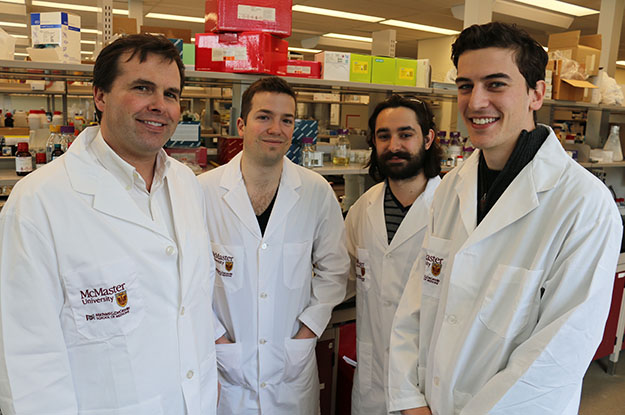Big data approach to finding new natural antibiotics attracts federal funding

Left to right: Team leader Nathan Magarvey, Chad Johnston, Chris DeJong and Phil Rees. 'We have been searching for a long time for antibiotics – but only now are we seeing the forest from the trees, as now we are able to observe nature’s entire antibiotic collection,' said Magarvey.
An international research team led by McMaster scientists has received major funding from the Canadian government to discover and develop natural antibiotics for treating drug resistant bacteria.
The $1.5 million in funding is the largest of six grants for Canadian research teams announced by the Ministry of Health today as part of the government’s response to the threat of antimicrobial resistance.
Nathan Magarvey of the Michael G. DeGroote Institute for Infectious Disease Research at McMaster is the leader of the team that includes colleagues from British Columbia, the United Kingdom, France and Israel. Several European research agencies are matching the Canadian funding.
Together, the alliance will exploit the approaches developed by the Magarvey team to handle big data, which is the exponential growth and availability of information which can lead to more accurate analysis.
The blueprints for the production of natural antibiotics within microbes are now recognized to be encoded within producers genome in what are known as clusters. Magarvey’s team is scanning genomes for these antibiotic clusters, and has collected data from all of the now sequenced genomes – and they have predicted the new antibiotics that await discovery.
Magarvey’s team devised a molecular protocol to compare the known naturally occurring antibiotics (consisting of tens of thousands of natural antibacterials produced by microbes) to those that are inferred from genomic sequence data.
In preliminary work they have mined over 500,000 genomic sequences from microbes in Canada and around the globe – and inferred which of those unknown antibiotics may form the basis of new treatment options for drug resistant bacteria. The team has also developed an approach to selectively isolate these new antibiotics.
“We have been searching for a long time for antibiotics – but only now are we seeing the forest from the trees, as now we are able to observe nature’s entire antibiotic collection,” said Magarvey, an associate professor of biochemistry and chemical biology at McMaster and the Canada Research Chair in Natural Products and Chemical Biology.
The McMaster-led team is interdisciplinary, including computer programmers, big data experts, machine learning scientists, biochemists, chemists, genome specialists and microbiologists.
Modern technology has put the team “light years ahead of a few years ago,” Magarvey added. “Now we have the data and the tools we need to mine that data for new antibiotic agents. I am super excited to embark on this bold new venture with my laboratory colleagues who have constructed the big data/graph database to navigate the unseen microbial world for new drugs.”
